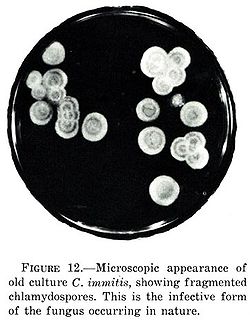Azoles
The introduction of azoles revolutionized treatment for coccidioidomycosis, [14] and these agents are usually the first line of therapy. However, none of these azoles are safe to use in pregnancy and lactation because they have shown teratogenicity in animal studies.
Of the azoles, ketoconazole is the only one approved by the U.S. Food and Drug Administration (FDA) for treatment of coccidioidomycosis. Nevertheless, although it was initially used in the long-term treatment of nonmeningeal extrapulmonary disease, more-potent, less-toxic triazoles (fluconazole and itraconazole) have replaced it. Itraconazole (400 mg/day) appears to have efficacy equal to that of fluconazole in the treatment of nonmeningeal infection and have the same relapse rate after therapy is discontinued. However, itraconazole seems to perform better in skeletal lesions, whereas fluconazole performs better in pulmonary and soft tissue infection. Serum levels of itraconazole are commonly obtained at the onset of long-term therapy because its absorption is sometimes erratic and unpredictable. Complications can include hepatic dysfunction. For patients who are unresponsive to fluconazole, options are limited. Several case reports have studied the efficacy of three newer antifungal agents in the treatment of disease that is refractory to first-line therapy: posaconazole and voriconazole (triazole compounds similar in structure to fluconazole) and caspofungin (glucan synthesis inhibitor of the echinocandin structural class). However, these drugs have not been FDA approved, and clinical trials are lacking. Susceptibility testing of Coccidioides species in one report revealed uniform susceptibility to most antifungal agents, including these newer drugs.
In very severe cases, combination therapy with amphotericin B and an azole have been postulated, although no trials have been conducted. Caspofungin in combination with fluconazole has been cited as beneficial in a case report of a 31-year-old Asian patient with coccidioidal pneumonia. In a case report of a 23-year-old Black male with HIV and coccidioidal meningitis, combination therapy of amphotericin B and posaconazole led to clinical improvement.
Posaconazole has been approved by the European Commission as a salvage therapy for refractory coccidioidomycosis. Clinical trials are now ongoing for further evaluation. Voriconazole is also being studied in salvage therapy for refractory cases. A case report indicated that voriconazole in combination with amphotericin B as salvage therapy for disseminated coccidioidomycosis was successful.
Several case reports have studied caspofungin, with differing results. Caspofungin 50 mg/day following administration of amphotericin B in a patient with acute pulmonary coccidioidomycosis who had undergone transplantation showed promising results. In a patient with disseminated coccidioidomycosis, first-line therapy with amphotericin B and caspofungin alone failed to elicit a response, but the patient was then given caspofungin combined with fluconazole, with good results. A published report described a patient with disseminated and meningeal coccidioidomycosis in whom conventional therapy with fluconazole, voriconazole, and amphotericin B failed; caspofungin 50 mg/day after a loading dose of 70 mg intravenously was also unsuccessful.
Duration of therapy and costs
The objectives of treatment are resolution of infection, decrease of antibody titers, return of function of involved organs, and prevention of relapse. The duration of therapy is dictated by the clinical course of the illness, but it should be at least 6 months in all patients and often a year or longer in others. Therapy is tailored based on a combination of resolution of symptoms, regression of radiographic abnormalities, and changes in CF IgG titers. Immunocompromised patients and patients with a history of meningeal involvement require lifelong treatment.
The cost of antifungal therapy is high, from $5,000 to $20,000 per year. These costs increase for critical patients in need of intensive care. Arizona spent an average of $33,762 per patient with coccidioidomycosis between 1998 and 2001.



